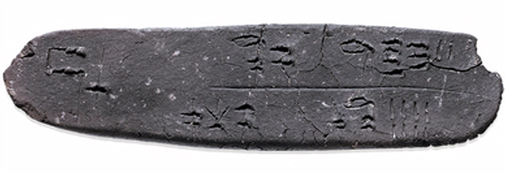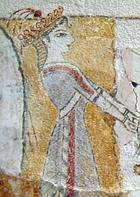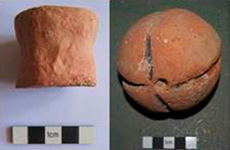
Copyright: Trustees of the British Museum
FABRIC project
Weaving the Fabric of Society: Bronze Age Aegean Economies of Cloth
By Joanne Cutler, Marie Curie Intra-European Fellow, Gerda Henkel Stiftung
The focus of the FABRIC project is the Middle and Late Bronze Age (second millennium BC) Minoan and Mycenaean textile industries on Crete, with selected comparative case studies of sites beyond Crete. The production and consumption of textiles constituted a core aspect of economy and society in the Bronze Age Aegean.
As in most ancient communities, there would have been a demand for a wide variety of textiles, including clothing, sails, bedding, sacking, wall-hangings, and coverings for floors and furniture. These textiles would have been produced in different qualities, using different techniques, tools and raw materials.
The manufacture of cloth, from fibre procurement to finished fabric, is an extremely labour intensive process, and would have had an impact at every social level within all communities. The study of textile production is therefore integral to our understanding of Aegean Bronze Age societies.

Photo: Joanne Cutler
In the Aegean, the Late Bronze Age (LBA) Linear B tablets from Knossos on Crete and from centres on the southern Greek mainland document the existence of major palatial textile industries, which were highly specialised and large-scale, during the Mycenaean period (c. 1490-1200 BC). The documents from Knossos list c. 100,000 sheep and an estimated 1,000+ adult female weavers that were overseen by the palace.
In contrast, for the preceding Minoan palatial periods on Crete (c. 1950-1490 BC), the archaeological record provides extensive evidence for textile production at both palatial and non-palatial sites, but negligible textual evidence for the scale and nature of the textile industry is preserved (Minoan palatial period data for Crete and the wider southern Aegean was analysed in my PhD thesis: Crafting Minoanisation: Textiles, Crafts Production and Social Dynamics in the Bronze Age Southern Aegean).
Nevertheless, the few earlier Linear A tablets from Crete do indicate that the palatial Mycenaean textile industry developed out of an already established Minoan textile production system. Considerable research has been undertaken on the Knossian Linear B evidence for textile production.
By combining the textual dataset with the study and analysis of the archaeological dataset from LBA Crete, in conjunction with the iconographic evidence, it is possible to gain new insights into the nature, scale and organisation of textile production during the Mycenaean period.
This will provide a new and richer text-informed model to compare against the previously studied evidence for the preceding Minoan palatial periods (with selected additional case studies also now being conducted). By considering the Minoan and Mycenaean evidence for the production and consumption of textiles in comparative perspective, the FABRIC project seeks to generate a new understanding of both systems.


The project aims to produce valuable new insights into the social and economic value of cloth within Aegean societies and to provide new information on contemporary networks of trade and networks of knowledge, developing a new window into processes of socio-economic change, the transfer of craft skills and the gendered nature of craft production in Bronze Age Aegean societies.
Assessment of the archaeological evidence utilises recently developed methods for the analysis of textile tools pioneered at CTR, which now make it possible, through the functional analysis of loom weights and spindle whorls, to ascertain the types of textiles that could have been produced at specific sites and in particular contexts, even though the textiles themselves have rarely survived.
New perspectives on institutional, household and individual economic and social strategies will be gained by further considering the evidence for the Aegean industries within the context of the large-scale manufacture and circulation of textiles in the wider Eastern Mediterranean, where extensive written records demonstrate that the intensive production and exchange of textiles were fundamental components of the highly developed economies of Eastern Mediterranean Bronze Age complex societies, with cloth being produced at a variety of scales, to serve economic, social and political aims.
By considering textile production within its broader cultural context, the objective of the FABRIC project is to better integrate the evidence for textile production and consumption into wider research on Bronze Age Aegean economy and society.
